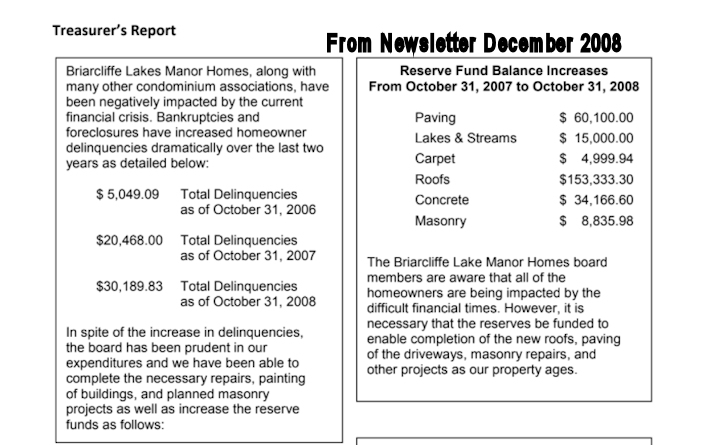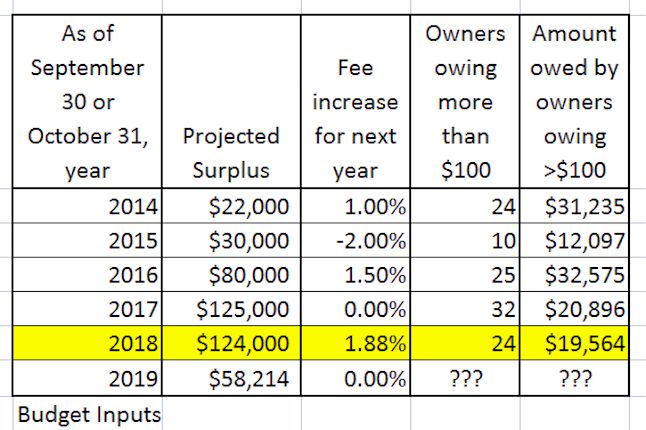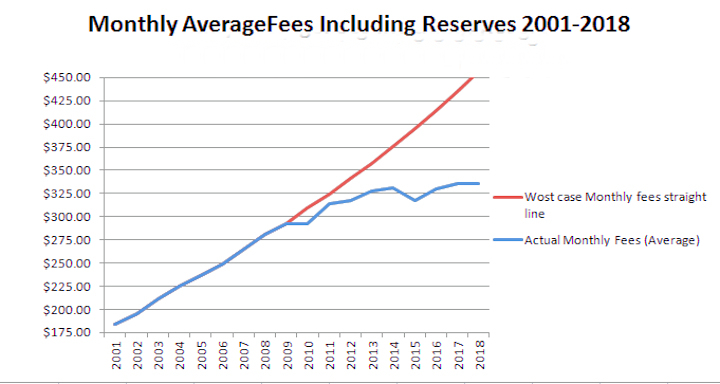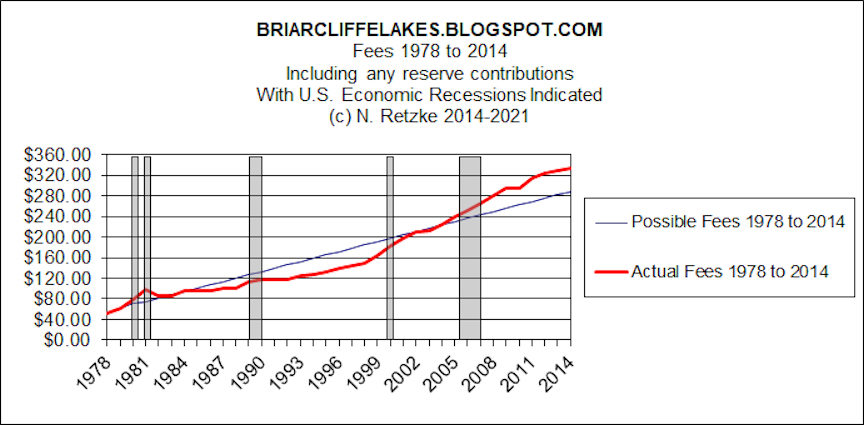 |
When a street fails and the stone base is damaged,
complete replacement becomes necessary.
This includes portions of the stone base, as well as all layers of asphalt.
It may also require curb and basin repairs or replacement.
It is expensive.
|

The Notes are an important part of this post. Three or more of the current board members participated on boards 2012-2018, made decisions or were present when they were made, and they experienced what is depicted in the photos (Note 5).
For more posts about street repairs, go to Note 10.
This post is a case study and I use the streets of the association as an example.
A lot of association money, which is to say, owner fees, has been spent repairing and replacing streets at BLMH since 2002. In fact, streets installed at great cost during 2002-2003 showed signs of premature failure in 2007. (Note 6). That was one of my motivations to join the board. It has been my position that owners can ill afford the fees required to deal with premature failures of major projects, which are a consequence of board and contractor failures.
Boards will argue that they aren't professionals. Considering the size and age of the association, my position has been:
- We need capable professionals on the board.
- We need more skillful and capable boards.
- Board members should be aware of their limitations and act accordingly during votes.
- Boards must be comprised of individuals who will act as fiduciaries on behalf of all owners. Some board members think they represent and act on behalf of, and in the best interests of, the association, which is a not-for-profit corporation. They don't. They represent the owners who are the shareholders.
I'm a proven, competent professional and I joined the board in September 2010. I enrolled a Certified Public Accountant to join the board in 2011. See the "Board Leadership" insert at the end of this post (Note 9). However, prior leadership and some board members weren't enthusiastic about the changes. In fact, an earlier president once complained during a meeting that "Norm is spending all of the money." That was a distortion because all undertakings were via vote of the entire board. Directives were then issued to management. Some board members decided to stonewall and delay. As a consequence capable board members left in frustration. The CPA left the board, a maintenance director left, and I left in September 2018. It is no surprise to me that the boards 2019-2022 reverted to earlier methods.
That reversion is now complete with the decision of the 2022 board to replace of the management company.
Better Methods Achieve Better Results - A Prequel to the Street Projects
By 2008 it was apparent that Lakecliffe, a recently replaced street, was failing prematurely. Significant and extensive patching was required. Management acknowledged in the July-August, 2013 newsletter that "the [previous] replacement of this street [Lakecliffe] only lasted 5-7 years and required repairs thereafter." (Note 6).
I led the negotiations with the contractor and the association obtained four years of resurfacing and patching at no cost. I couldn't reverse what had occurred, but I could do what was necessary to extend the life of the street so that the roofing project could be completed, other necessary work in the association be done, and plans could be made for a proper replacement.
As a board member September 2010-September 2018, I pressed the boards to hire competent professional engineers and project engineers to determine the life of the streets and the best means and methods to conduct repairs. The goals included:
- Maintain the streets which are vital for resident access.
- Spend the fees collected thoughtfully and carefully.
- Develop long term programs using facts, data and expert opinions. Avoid guesswork.
- Stabilize fees using better maintenance and financial controls.
- Avoid unnecessary delays which exacerbate problems and result in more costly failures.
In fact, one board member suggested during a board meeting in 2013: "Norm, you could prepare the specifications for the streets." I forcefully declined. That approach is precisely why our streets failed prematurely. Instead, I promoted the retention of a professional engineering firm and a firm to literally dig deeper into the streets to determine the cause of failures using core samples. I enrolled the board to vote do so. Some reluctantly voted "Aye".
Of course, that meant spending money. Some board members are "penny wise and pound foolish", and remain resistant to this day. Oh, and don't let their professional credentials or professed experience fool you. It is best to observe them in action and ignore their "Candidates Form" as elections approach. But too few owners are sufficiently motivated to monitor the board.
Streets Replaced, the Schedule, Owner Communications and Expenditures
In 2013-2015 Lakecliffe and Salisbury were replaced in their entirety with a properly engineered street designed for 20-30 years or more of good life with proper annual maintenance. To achieve this would require crack filling, application of preservative GSB-88 and periodic top layer milling and replacement. That maintenance has not occurred, but a bid was obtained in 2018 and this was scheduled for 2019.
Professional engineers and project managers were retained over a period of three years to provide overall guidance and to see that the Lakecliffe street project was properly designed and installed 2013-2015.
Work continued on some of the other streets with less engineering supervision during 2016-2018. This was in accordance with plans provided by the engineers and the reserve studies. All immediate major work was to be completed by 2022. However, boards 2019-2021 disrupted that plan. It is unclear if subsequent repairs will be completed by 2025.
For example, Thames was resurfaced in 2018. Curb and basin work was done on Harrow and a large section resurfaced 2016-2018. A large section of Dover was resurfaced and asphalt patches were applied on Plymouth. In the year 2018 $102,934 was spent on street repairs.
However, this work is incomplete. In fact, Plymouth, Dover and Harrow were to be completely resurfaced 2019-2022. Gloucester would be completed by 2025.
Boards were aware of the condition and financial requirements to complete the repairs in a timely manner. (Note 3). There were a number of surveys and professional reports. These were supplemented by surveys conducted by me and our soon to be former managers.
I prepared the following chart. It summarized the situation and projected $229,290 for the initial phase of street repairs in the period 2018-2022. The 2019-2021 boards included two members who were present for all these discussions and decisions, including the reserve studies. They discussed these charts during association meetings. (Note 7).
Owners were also made aware. This was a topic in newsletters and board meetings, and I include a link here to the July-August, 2013 newsletter.
Coincidentally, the 2022 board has voted to replace that management company and that manager.
Reserve studies commissioned 2010, 2011 and 2015 provided additional financial insights and guidance. Lakecliffe and Salisbury were replaced in 2014-2015, Thames in 2018, but other streets remained.
Here is the plan that owners and boards were well aware of:
- Sequential expenditures required for remaining street repairs to be completed 2018-2022: $229,290
- Total, possible expenditures for street repairs to be completed 2016-2025: $467,026.
However, delays could be even more costly, and the board members know that. Anyone who was a resident 2013 to the present day experienced the consequences of previous delays and poor decisions.
This is a chart presented by me used during the annual meeting held in September 2016. It provides a 10-year expenditure summary of all major categories using reserves of the association. To create it I used all of the condition reports, surveys and financial information that was available to all board members.
 |
My chart presented to owners during the September, 2016 Annual Meeting
(c) N. Retzke 2016-2021
|
Delays to Street Repairs increase Costs; coordination issues
I left the board in September 2018, as did the treasurer and maintenance director. This left other experienced board members, two with decades of experience to lead and complete the plans, part of which were outlined in the "Guidance" insert of the August, 2018 Newsletter (Note 8).
Subsequent boards 2019-2021 have failed to complete the initial phase of the program. It is unclear what the board intentions are.
The problem with delays is that the repairs become more costly as the street base deteriorates. As the stone base deteriorates, the repairs required become more extensive and that drives costs upward.
Boards also knew that we have been in a "sweet spot" regarding inflation. Low inflation facilitated repairs at lower cost and saved our owners a lot of money. That too, has helped to stabilize fees. But some board members are oblivious. I suspect the board of 2022 will face higher costs and more resource competition.
Awareness of such forces was also a motivation in my decisions and those of the presidents, treasurer and maintenance director 2015-2018. As competition for resources heats up, it becomes more difficult to find and schedule competent contractors. Resources include competent contractors as well as materials.
Such inflation concerns and potential price increases, as well as the condition of streams and water consumption was a motivation to do substantial stream repairs in the period 2016-2018. This work had been delayed to so as to complete the roofing project as well as Lakecliffe and Salisbury street and related water main replacements during the period 2012-2018. Some board members could not understand the urgency and I am convinced they never will.
So many roofs were completed in 2014 that it was prudent to delay major street repairs. However, street patching continued while the roofing project was being completed. It was impossible to properly evaluate and manage the street construction and consider the coordination of roofers, pavers, concrete, etc. There were other repairs underway including walks, driveways, garage floors, stream repairs, basins, curbs, common area bridges and patios and so on. Here's an annual count of the roofs completed while I was Architecture & Maintenance director. Leak reports and extensive surveys both outside the roofs and inside the attics determined the condition and sequence of replacement:
- 2011 = 6 roofs (six 8-unit)
- 2012 = 6 roofs (five 8-unit and one 4-unit)
- 2013 = 6 roofs (five 8-unit and one 4-unit)
- 2014 = 8 roofs (eight 8-unit buildings).
- 2012-2018 drainage work related to all roofs (84 entries and other areas).
The Board Decision Cycle can be an Impediment
I always attempted to determine annual projects during the winter and lock-in board decisions in the first quarter of each year. This allowed the board to obtain bids and get contractor commitments and better prices. Contractors are motivated to give better prices in the winter or early in the year, so as to build a schedule and establish some certainty for their company and schedule their workers.
Most boards don't begin annual planning until after the Spring thaw and that is too late in the year to begin. Consider the board decision cycle which can require many months:
- Board discusses projects and alternatives, tables decisions by a month or more.
- Board decides which projects to complete during the current year.
- Board directs management to get bids, etc.
- Board reviews bids and if necessary gets clarifications.
- Board selects the contractors.
- Work is finally scheduled.
Major Expenditures including Streets in 2018
Inflation concerns, pricing and stream condition was a serious motivator to do substantial stream repairs in the period 2016-2018. This work was delayed so as to complete the roofing project as well as Lakecliffe, Salisbury and Thames streets and related water main replacements during the period 2013-2018. Some board members could not understand this and I am convinced they never will.
 |
Presented during the 2018 Annual Meeting
I kept owners informed. Image (c) N. Retzke 2018-2021.
|
Streets Schedule, Additional Information and Being Fully Informed
I prepared and provided additional information to the board and to owners about the status, estimates and costs of street repairs. I won't provide detailed spreadsheets here, because they include information that potential bidders would find interesting and might influence future bids.
The boards of 2013-2018 took a lot of steps to be fully informed about the condition, remaining life, and costs and annual expenditures to deal with failed and failing streets. We made a lot of decisions about streets, including commissioning sophisticated tests to determine why some were in such poor condition and others were failing (Ref: 2013, 2014). A consulting engineering firm retained for this purpose advised the boards during that period that streets needed to be replaced, and extensive repairs made by 2022. I've included photos and a table in this post. (Notes 3, 4, 5).
Using professional guidance, extensive street replacement and repairs were made during the period 2012-2018. This phase of the work was supposed to continue and all street asphalt work was to be completed by 2025. This was considered sufficiently important to be an item in my "Guidance" Newsletter insert to owners and future boards in 2018. That was my final newsletter.
The boards of 2019, 2020 and 2021 decided not to do these repairs. Dover, Plymouth and Gloucester show even more checkering today, and whole sections are failing. The board also decided not to apply GSB-88 preservative to Lakecliffe. That's a proven technique used to extend the life of streets in Wheaton and by other nearby communities. I obtained a proposal in 2018 and it was to have been implemented by the board of 2019.
It is a fact that road deterioration caused by delays to road repairs, including a lack of crack filling, will result in higher replacement costs (Note 2). Higher costs mean higher owner fees.
Spreadsheet Details
There is a spreadsheet behind the chart "Projects 2018 Major Categories". That chart is shown in this post and it uses extensive data. The spreadsheet included the actual cost for:
- Cost of asphalt, curbs and sewer Lakecliffe Project 2015.
- Cost of replacement of asphalt and curbs, Lakecliffe Project 2014.
The spreadsheet included the cost of asphalt, curbs and gutters for:
- Cost of Thames asphalt, per bid.
- Estimated cost for Harrow asphalt work.
- Estimated cost of Dover asphalt work.
- Estimated cost of Plymouth asphalt work.
- Estimated cost of Gloucester asphalt work.
- Additional estimated costs of concrete curbs and gutters.
- The total cost of all of the above.
To prepare the spreadsheet I included the lineal feet of each roadway, the percent of roadways for each of the streets and extrapolated costs for:
- Lakecliffe + Salisbury.
- Thames.
- Harrow.
- Dover. Plymouth. Gloucester.
- Total lineal feet of all streets in the Association.
Notes:
Note 1. Three of the 2019-2022 board were present during the annual meeting which included extensive presentations about costs, projects and planned expenditures, Other board member(s) were owners at the time and were also present. Two of the 2019-2022 board members were on the boards for
all decisions, votes, presentations and reports discussed in this post.
Note 2. Boards in the period 2013-2015 were made fully aware of all of the issues of association roadway factors. This included deterioration, the consequences of delays to repairs, and the potential failure of roadway stone base. The association hired a professional engineering firm, conducted additional professional tests of all of the Roadways and so on. All of that information was discussed at length by the boards at the time. The current board has two members who have decades of experience and were present for all of those discussions, reports and presentations. They were also on the board and present during the entire replacement of Lakecliffe, Salisbury and Thames, and the water mains beneath. Yet, they decided not to do the curb, basin and street repairs and resurfacing of Dover and Plymouth scheduled for 2019 - 2021. Based upon condition, Gloucester could be done as early as 2022.
Note 3. A thorough engineering study of the streets was conducted in 2014. The data in that study was provided to the board and this information was used as part of the decision making process to completely replace Lakecliffe and Salisbury in 2014-2105. It was also used to resurface Thames in 2018, to make extensive repairs to Dover and Harrow Ct. , and to patch Plymouth. Studies recommended additional repairs or complete replacement of Dover, Plymouth and Gloucester. Only partial repairs have been made to Harrow Ct.
Note 4. Street Survey - My summary spreadsheet of the engineering studies. Note that
5 inches of asphalt is considered the minimum for residential streets per the Consulting Engineering firm that prepared the reports. BLMH streets had a
total asphalt thickness of as little as 2.0 inches:
Note 5. This is what happens when boards and contractors fail. I had to clean up the mess in the following photos, which required the entire replacement of Lakecliffe and Salisbury. Thames was resurfaced and additional, large patches covering entire street sections were done on Dover and Harrow. The boards 2019-2021 decided to ignore the engineers (the two most senior members of those boards have decades of experience on the board. They were present and voted during all of the street repairs after 2013 and were fully briefed and involved in all street decisions and voting.).
 |
| Checkering leads to holes. That's a yardstick in the photo |
 |
Checkering leads to holes - that's a yardstick in the photo
|
 |
A patch may provide a short-term solution, but the
problem will spread, damaging the street base |
 |
Delaying the replacement of asphalt leads to
more serious street destruction
which is more expensive to repair |
 |
Ultimately, the entire street including all patches will fail,
because the stone base is damaged, has failed, and cannot
support the asphalt resting upon it. |
 |
When a street fails and the base is damaged,
complete replacement becomes necessary.
This includes portions of the stone base, as well as all layers of asphalt.
It may also require curb and basin repairs.
It is expensive. |
Note 6. FUPM was the property manager during the street work that occurred 2002-2003. G&D Property Management later replaced FUPM. G&D was the manager during the street replacement project 2010-.
Note 7. I suggest that the reason boards made expenditures 2010-2018 include earlier board inaction or decisions:
- A lack of urgency by long term board members: "We can do it next year, or the next, etc.".
- A need to catch-up when avoidance becomes impossible, or owners become angry. Eventually failures of infrastructure can no longer be ignored. Owners wake up.
- Board decisions 2002-2005, including the faulty replacement of streets during that period. Most financial resources were allocated to the expensive roofing project which required perhaps $2 million including roofs and associated drainage.
- A failure of boards to perform other timely repairs and maintenance.
- A preference of earlier boards to defer and "kick the can down the road" to later boards.
- An inability to set meaningful priorities.
- Personal agendas.
- Putting beliefs ahead of facts.
- An desire by board members to maintain personal appearances and to be re-elected.
- The age of the association and infrastructure.
Note 8. "Guidance" Newsletter insert, August 2018:
Note 9. Board leadership (presidents) 2001-2019:
Note 10. Street Posts in chronological order, oldest first, most recent is last:
Lakecliffe Failure – some Notes:
Lakecliffe Street Engineering Study:
Lakecliffe Street Construction – Part 1
Lakecliffe Street Construction - Part 2
Lakecliffe Street Construction - Conclusion
Salisbury Street Construction
Thames Street Construction
===
(c) N. Retzke 2021

![]()












































